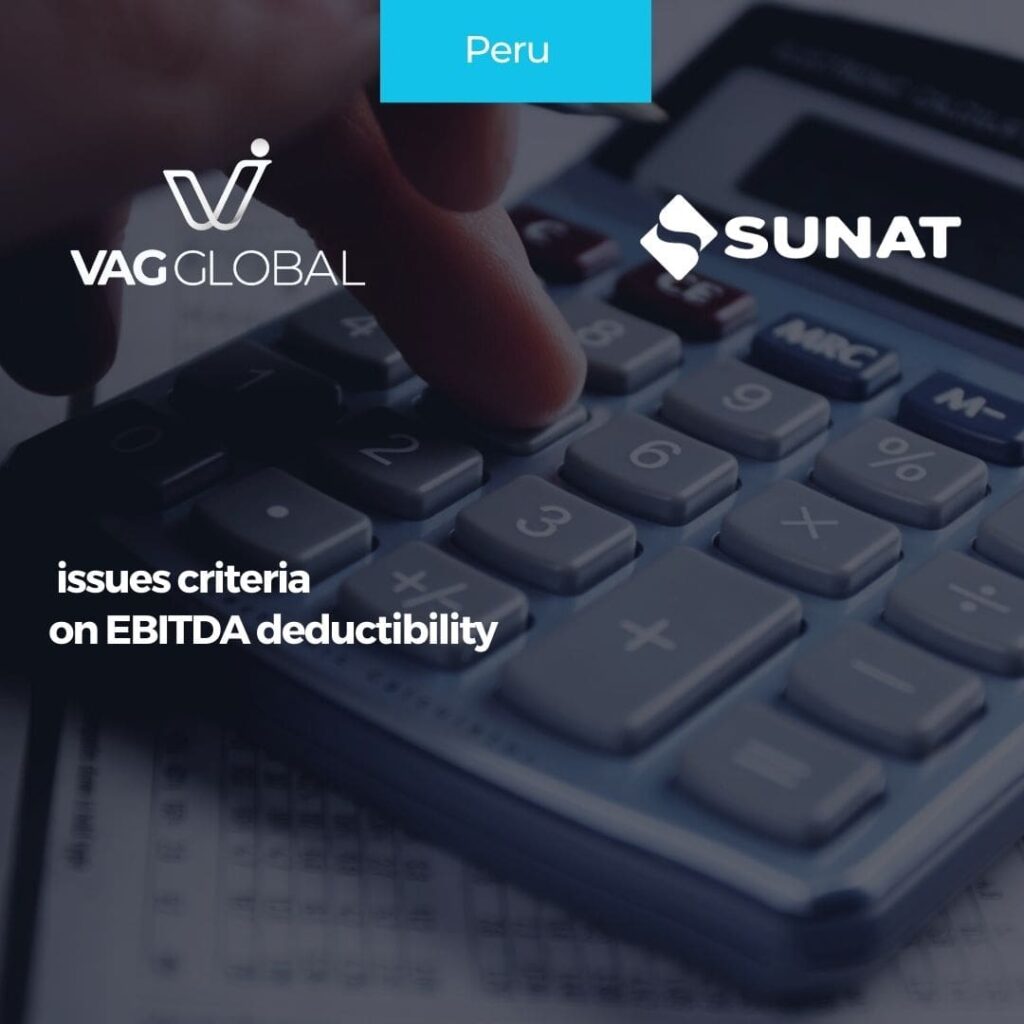Through Report No. 094-2021-SUNAT/7T0000, SUNAT (Superintendencia Nacional de Aduanas y de Administración Tributaria – National Superintendency of Customs and Tax Administration) pronounces aspects related to EBITDA (Earnings Before Interest, Taxes, Depreciation, and Amortization) deductibility.
1. Consultations
Concerning the interest expense deduction limit, regulated by Article 37 of the Income Tax Law, whereby net interest exceeding 30% of the EBITDA of the previous year is not deductible, the following consultations are formulated:
- The concept of “net income” included in the definition of EBITDA. Is it the amount resulting from the application of the rule provided in Articles 37 and 44 of the Income Tax Law and all other tax regulations that affect its determination?
- If by applying paragraph g) of Article 44 of the Income Tax Law, it is deducted as an expense the total amount paid for an intangible asset of limited duration for a single fiscal year, how should such amount be considered in the concept of “amortization” included in the definition of EBITDA?:
- Should it be added in its totality to know the EBITDA of the year the totality deducted thereof for the Income Tax purposes and in the following years 1/10 of the amount fully added in the first year should be added; or
- Shall the following 10 fiscal years be added at the rate of 1/10 of the total amount paid for the limited duration intangible for each fiscal year?
2. Analysis
First consultation
Deductibility of interest expenses
Article 37(a) of the Income Tax Law provides that interest on debts and expenses arising from the constitution, renewal, or cancellation thereof are deductible, provided that they have been incurred to acquire goods or services related to the obtaining or production of taxable income in the country or to maintain the source of such income.
In the same line, the first paragraph of numeral 1 of the aforementioned subsection establishes that net interest exceeding 30% of the EBITDA of the previous year is not deductible.
It should be noted that for taxpayers starting activities in the year, the EBITDA of such year will be considered.
Now, according to the aforementioned paragraph, it is understood by:
- Net interest means the amount of interest expense over the amount of interest income computable in determining net income;
- EBITDA, the net income after offsetting losses plus net interest, depreciation, and amortization.
In turn, this paragraph indicates that net interest that could not be deducted in the year because it exceeds 30% of EBITDA may be added in the following four years.
Tax or accounting concept
Now, for the first query, it will be necessary to determine whether the terms or concepts of EBITDA are those established for accounting or tax purposes and, based on this, determine whether the rules of the Income Tax Law are or are not applicable for its calculation.
To do so, it is necessary to land on the explanatory memorandum, which incorporated paragraph a) of Article 37 of the Income Tax Law. This proposes that the EBITDA be built on the tax base to prevent it from being manipulated to increase the limit.
Therefore, the concepts necessary for the calculation of EBITDA must be understood in its tax definition, which is why the concept of net income has to be established based on the provisions of said law.
Definition of “net income”
Article 37° of the Income Tax Law provides that for determining the net third category income, it is deducted from the gross income, the deductible expenses allowed by law.
Therefore, the expenses detailed in Article 44 of the Income Tax Law will also be important since they expressly indicate which are prohibited.
Likewise, any other rule affecting the determination initiated will be equally applicable.
In conclusion, the “net income” included in the definition of EBITDA is the amount resulting from the application of Articles 37 and 44 of the Income Tax Law and any other tax regulation that affects its determination.
Second question
Article 44 (g) of the Income Tax Law states that the price paid for intangible assets of limited duration, at the taxpayer’s option, may be considered as an expense and applied to the results of the business in a single year or be amortized proportionally for ten (10) years.
According to paragraph 8 of IAS 38 Intangible Assets, amortization is: “the systematic distribution of the depreciable amount of an intangible asset over the years of its useful life.”
In this regard, it follows that any case of tax deduction of the value of an intangible asset not involving a systematic distribution of the depreciable amount over several years does not qualify as amortization.
3. Conclusion
Regarding the limit for the deduction of interest expenses provided for in Article 37(a)(1) of the Income Tax Law, whereby net interest exceeding 30% of the EBITDA of the previous year is not deductible:
- The concept of “net income” included in the definition of EBITDA is the amount resulting from the application of the rule provided in Articles 37 and 44 of the Income Tax Law and any other tax regulations that affect its determination.
- If by applying paragraph g) of Article 44 of the Income Tax Law, the total amount paid for a limited duration intangible asset in a single year is deducted as an expense, no amount will be considered as amortization to calculate EBITDA in the year in which the deduction was made or in the following years.
Fuente: SUNAT 09/11/21

